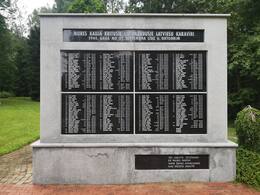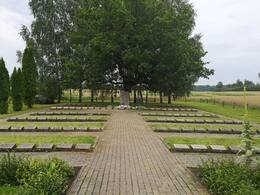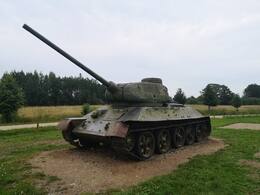Morės mūšiai
Morės mūšis buvo vienas aršiausių mūšių Latvijos teritorijoje per Antrąjį pasaulinį karą. Juose latvių legiono 19-oji divizija atmušė Raudonosios armijos bandymus prasiveržti į Rygą, o tai leido atitraukti vokiečių pajėgas iš Estijos. Mūšiai truko nuo 1944 metų rugsėjo 25 iki spalio 6 dienos. Legionieriai didvyriškose kovose atmušė dešimteriopai pranašesnes Raudonosios armijos pajėgas.
1944 m. rudenį Raudonoji armija užėmė visą Latgalą, sutelkė kariuomenę Lubanos pusėje ir suformavo puolimo smaigalį Rygos įlankos link, siekdama atkirsti Pietų Estijoje įsikūrusios Vokietijos armijos grupės „Nord“ dalis, taip pat padalinti 16-ąją armiją. Raudonoji armija susidūrė su vokiečių 18-ąja armija, įskaitant 19-ąją latvių legiono diviziją, iš pradžių prie Lubano ežero, vėliau traukėsi Barkavos, Aiviekstės ir Rankos mūšiuose, kol per Vecpiebalgą, Drusti, Sērmūkšie, Skujeni ir Nītauri pasiekė Morę.
1944 09 25 19 divizija užėmė More valsčiuje pastatytas Siguldos gynybines pozicijas. Sunkios kovos vyko penkias dienas. Devyni Raudonosios armijos batalionai buvo išsiųsti į dvi kuopos saugomas pozicijas Moreso centre, atakas palaikė artilerija, aviacija, tankai. Prieštankiniais pabūklais legionieriai sunaikino 4 tankus. Artilerijai pritrūkus sviedinių, latvių legionieriai dvi dienas turėjo ginti savo pozicijas nenutrūkstančioje ir itin sunkioje artimoje kovoje.
Rugsėjo 28 dieną Raudonajai armijai pavyko šturmuoti legionierių pozicijas prie Kārtužių. Kitą dieną, padedant šešiems vokiečių puolimo pabūklams, pažeidimas buvo pašalintas per kontrataką. Krito daug Raudonosios armijos karių ir jų pulko vadas. Per kitas dienas atakos susilpnėjo, o iki rugsėjo 30 d. Morės mūšis baigėsi. Latvių legionieriai savo žemėje savo misiją atliko – priešas buvo sustabdytas. Naktį iš spalio 5 į 6 d., 19-oji divizija įsakymu paliko Siguldos gynybines pozicijas ir spalio 6 d. Raudonoji armija su pastiprinimu užėmė tuščius Mores apkasus.
Žuvo apie 200 latvių karių, apie 650 sužeistų, o Raudonoji armija prarado apie 2700 žuvusiųjų ir 10 tūkst. sužeistųjų, buvo sunaikinti penki tankai T-34, numuštas vienas bombonešis IL-2. Morės mūšis yra ryškus Latvijos karių drąsos ir didvyriškumo pavyzdys, įrodytas šimtmečius.
Daugiau informacijos šaltinių
1. Mores mūšio muziejaus svetainė. Prieiga: http://www.moresmuzejs.lv/index.php?nod=21 [žiūrėta 2021 05 08].
2. Nacionalinių ginkluotųjų pajėgų svetainė. Prieiga: https://www.mil.lv/lv/latvijas-neatkaribas-kars [žiūrėta 2021-05-08].
Susijusi laiko juosta
Susijusios vietos
Mores Battle Memorial Park
The park was created in the former battle place in the Centre of More Parish where during the first two weeks of 1944 in the Second World War, major battles were held, holding thestrategically created defence line and preventing the Red Army from breaking through to Riga, thus affecting the further course of history.
You can see fragments of wartime relics and bunker sites here. A commemorative stone created by the sculptor H. Sprincis, as well as a Memorial Plaque with 186 soldiers names carved into the granite, are located in the Battles of More Memorial Park.
Red Army Brethren Cemetery in More
The Red Army Military Cemetery is located on the side of the main road through More. It is the final resting place for approximately 2000 soldiers who were killed during the Battle of More. In 1974 the cemetery was landscaped and a monument by sculptor B. Grīsle was unveiled.
Museum of Battles in More
The museum is located in More, on the side of the V319 motorway. It is dedicated to the Battles of More between the Red Army and the Latvian Legion of the German Army in the autumn of 1944. The exhibit includes a mock-up of the battlefield, weapons, awards, soldiers’ uniforms and military equipment. The Battles of More Museum and Memorial Park was established by former soldiers of the Latvian Legion who participated in the Battles of More. The memorial park features trenches, dugouts and battlefields. The battles in the More area were only part of a large-scale operation of the Red Army Baltic Offensive involving a total of 900,000 soldiers and large numbers of military equipment units. A part of the German Army fortification system where Latvian legionnaires prevented the Red Army’s attempt to break out to Riga was located in the vicinity of More. This allowed the German Army to withdraw its forces from Estonia and avoid defeat. Red Army leaders expected the enemy’s resistance near More to be short-lived and stubbornly continued its unprepared and uncoordinated attacks, suffering heavy losses. Local advantages and the combat capabilities of the Latvian legionnaires played a significant role in the subsequent course of the war. More is home to the Latvian Legionnaires’ Brothers’ Cemetery and a Red Army Soldiers’ Cemetery.
Susijusi istorija
Neatpažinti kariai. Kovos karininko istorija.
Moreso mūšis – tai paskutinio Antrojo pasaulinio karo etapo epizodas, turėjęs didelę reikšmę tolesnėje karo Latvijos teritorijoje eigoje. Morės mūšis – tai karo veiksmai, vykę 1944 m. rugsėjo 25–spalio 5 dienomis Siguldos gynybos linijoje More valsčiaus teritorijoje. Siguldos gynybinės linijos apkasuose, apie 12 km ilgio, Latvijos legiono 19-osios divizijos kariai, 10 dienų kovoję sunkias kovas su 10–15 kartų didesniu priešo pranašumu, sustabdė Raudonosios / Sovietų armijos dalinių veržimąsi Rygos link.








